Types of Whales in Sri Lanka
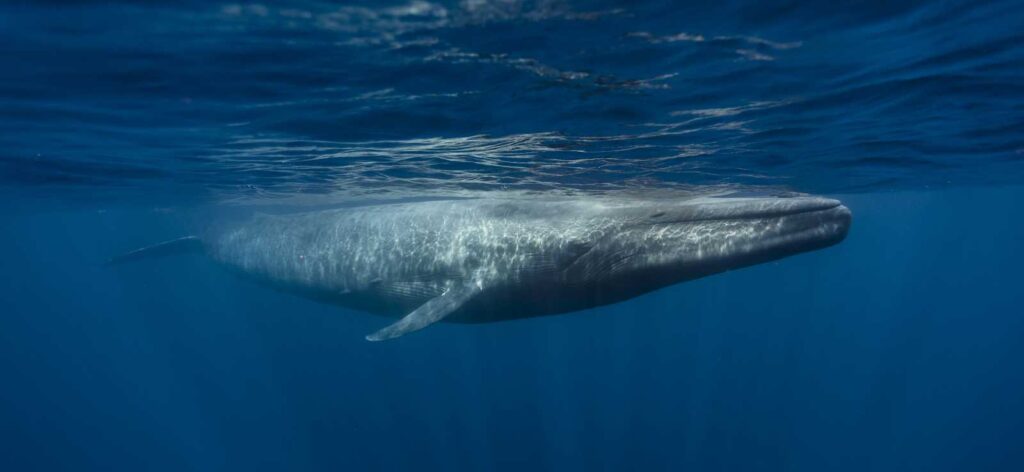
Blue Whale
The Blue Whale is the largest living creature on our planet, sometimes reaching lengths of nearly 100 feet and weighing more than 150 tons. Despite their immense size, these gentle giants feed almost exclusively on tiny shrimp-like crustaceans called krill, consuming several tons each day during peak feeding seasons. In Sri Lanka, Blue Whales are most frequently observed off the southern coast, particularly around Mirissa and Dondra Point, making the island one of the world’s premier locations for Blue Whale watching. They are identified by their long, streamlined bodies, bluish-grey coloration, and a tall columnar spout that can rise more than 30 feet into the air. Unlike many whale species that migrate to polar feeding grounds, some populations of Blue Whales near Sri Lanka are considered resident or semi-resident, taking advantage of the rich feeding grounds in the Indian Ocean. Their slow, graceful surfacing and powerful tail flukes make sightings unforgettable. The awe of encountering the largest animal ever known, moving effortlessly through the ocean, is a truly humbling and magical experience, offering visitors a rare chance to connect with one of nature’s greatest marvels in its natural habitat.

Blue Whale
The Blue Whale is the largest living creature on our planet, sometimes reaching lengths of nearly 100 feet and weighing more than 150 tons. Despite their immense size, these gentle giants feed almost exclusively on tiny shrimp-like crustaceans called krill, consuming several tons each day during peak feeding seasons. In Sri Lanka, Blue Whales are most frequently observed off the southern coast, particularly around Mirissa and Dondra Point, making the island one of the world’s premier locations for Blue Whale watching. They are identified by their long, streamlined bodies, bluish-grey coloration, and a tall columnar spout that can rise more than 30 feet into the air. Unlike many whale species that migrate to polar feeding grounds, some populations of Blue Whales near Sri Lanka are considered resident or semi-resident, taking advantage of the rich feeding grounds in the Indian Ocean. Their slow, graceful surfacing and powerful tail flukes make sightings unforgettable. The awe of encountering the largest animal ever known, moving effortlessly through the ocean, is a truly humbling and magical experience, offering visitors a rare chance to connect with one of nature’s greatest marvels in its natural habitat.
Sperm Whale
Sperm Whales, the largest of all toothed whales, are among the most fascinating species found in Sri Lankan waters. Growing up to 60 feet long, these whales are distinguished by their massive block-shaped heads, which house the largest brain of any animal on Earth. They are deep-diving predators, capable of plunging over 1,000 meters to hunt giant squid, fish, and other deep-sea creatures. In Sri Lanka, Sperm Whales are commonly seen near Trincomalee and Kalpitiya, often traveling in large pods that provide thrilling spectacles for whale watchers. Their powerful spouts and dramatic surfacing make them easy to identify from a distance. Social and intelligent, Sperm Whales often display coordinated group behaviors, strengthening their bonds within pods. Observing them in Sri Lanka is particularly special because the region offers some of the best opportunities worldwide to see multiple Sperm Whales at once. For marine enthusiasts, the sight of these enormous creatures resting, diving, or socializing is unforgettable. They play a vital role in maintaining the ocean’s ecosystem balance, making their presence both awe-inspiring and ecologically important. Sri Lanka’s waters are a safe haven for these giants, offering a rare glimpse into their fascinating underwater lives.
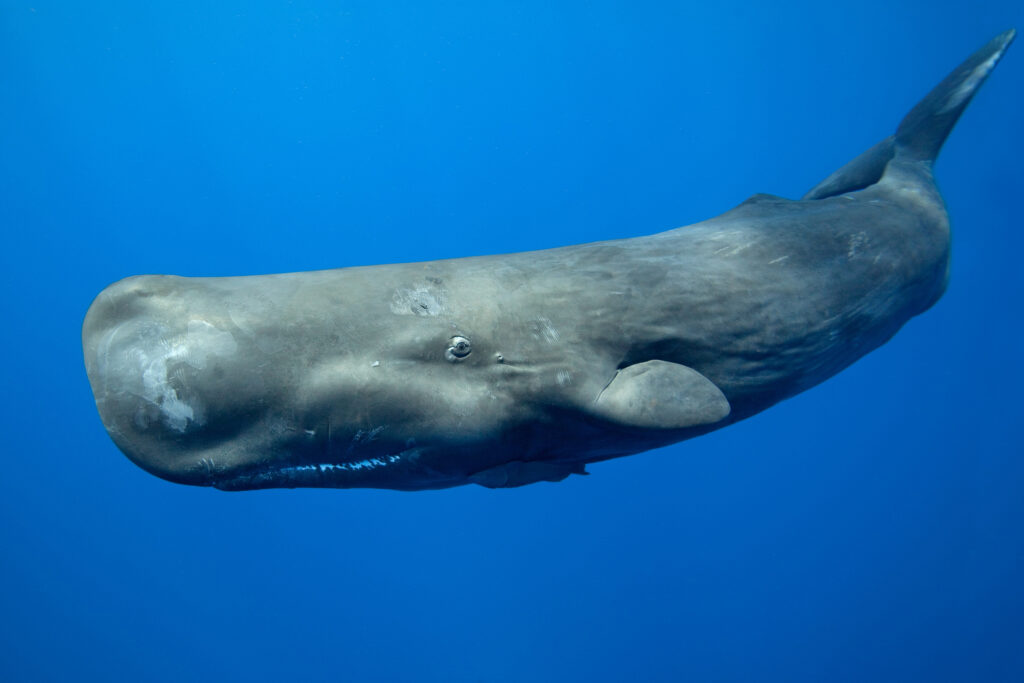

Sperm Whale
Sperm Whales, the largest of all toothed whales, are among the most fascinating species found in Sri Lankan waters. Growing up to 60 feet long, these whales are distinguished by their massive block-shaped heads, which house the largest brain of any animal on Earth. They are deep-diving predators, capable of plunging over 1,000 meters to hunt giant squid, fish, and other deep-sea creatures. In Sri Lanka, Sperm Whales are commonly seen near Trincomalee and Kalpitiya, often traveling in large pods that provide thrilling spectacles for whale watchers. Their powerful spouts and dramatic surfacing make them easy to identify from a distance. Social and intelligent, Sperm Whales often display coordinated group behaviors, strengthening their bonds within pods. Observing them in Sri Lanka is particularly special because the region offers some of the best opportunities worldwide to see multiple Sperm Whales at once. For marine enthusiasts, the sight of these enormous creatures resting, diving, or socializing is unforgettable. They play a vital role in maintaining the ocean’s ecosystem balance, making their presence both awe-inspiring and ecologically important. Sri Lanka’s waters are a safe haven for these giants, offering a rare glimpse into their fascinating underwater lives.
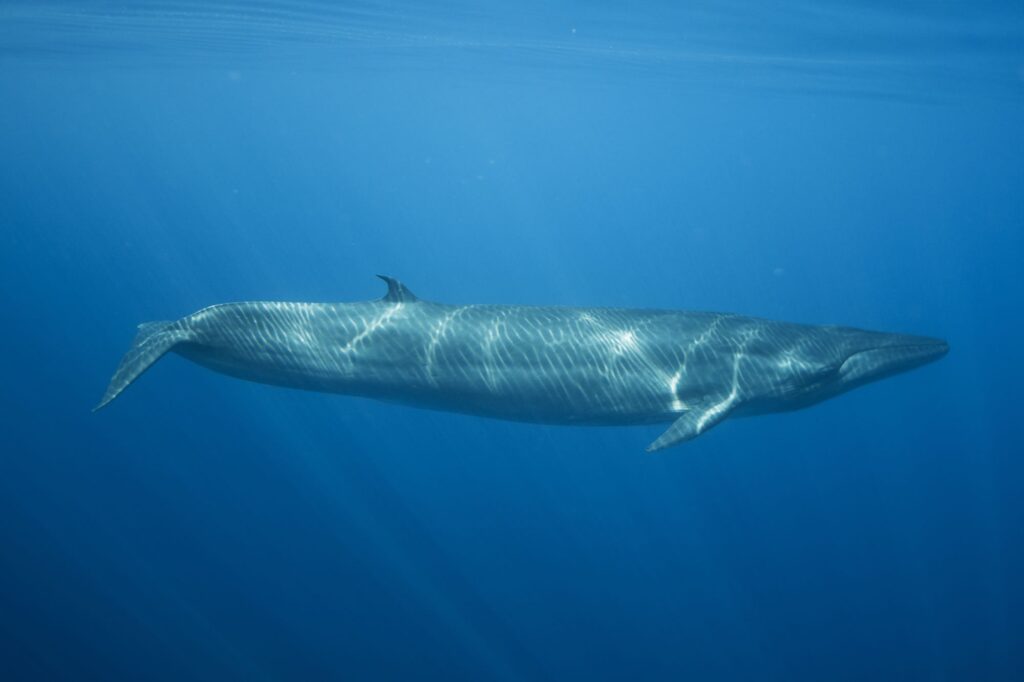
Bryde's Whale
Bryde’s Whales, though less commonly seen than Blue or Sperm Whales, are remarkable baleen whales that occasionally surface in Sri Lanka’s southern seas. These medium-sized whales grow between 40 and 55 feet and can weigh up to 25 tons. Easily recognizable by the three distinct ridges on their heads, Bryde’s Whales are fast, sleek swimmers and often surface gracefully, creating exciting moments for those fortunate enough to spot them. Their diet primarily consists of schooling fish like sardines and anchovies, though they also consume krill and plankton. They use a technique called lunge-feeding, where they rush through dense schools of prey with mouths wide open, swallowing huge quantities at once. Around Sri Lanka, sightings are rare but incredibly rewarding, as they add to the country’s reputation for marine biodiversity. These whales are known to be solitary or seen in small groups, making encounters more intimate compared to pod-dwelling species. Observing a Bryde’s Whale is a reminder of the ocean’s hidden wonders, where even less common species contribute to the rich marine environment. For whale watchers, spotting Bryde’s Whales is a prized moment that highlights the diversity and uniqueness of Sri Lanka’s thriving marine ecosystem.

Bryde's Whale
Bryde’s Whales, though less commonly seen than Blue or Sperm Whales, are remarkable baleen whales that occasionally surface in Sri Lanka’s southern seas. These medium-sized whales grow between 40 and 55 feet and can weigh up to 25 tons. Easily recognizable by the three distinct ridges on their heads, Bryde’s Whales are fast, sleek swimmers and often surface gracefully, creating exciting moments for those fortunate enough to spot them. Their diet primarily consists of schooling fish like sardines and anchovies, though they also consume krill and plankton. They use a technique called lunge-feeding, where they rush through dense schools of prey with mouths wide open, swallowing huge quantities at once. Around Sri Lanka, sightings are rare but incredibly rewarding, as they add to the country’s reputation for marine biodiversity. These whales are known to be solitary or seen in small groups, making encounters more intimate compared to pod-dwelling species. Observing a Bryde’s Whale is a reminder of the ocean’s hidden wonders, where even less common species contribute to the rich marine environment. For whale watchers, spotting Bryde’s Whales is a prized moment that highlights the diversity and uniqueness of Sri Lanka’s thriving marine ecosystem.
Short-Finned Pilot Whale
Short-Finned Pilot Whales are highly social marine mammals known for traveling in pods, sometimes numbering up to several dozen individuals. Growing up to 20 feet long, they are smaller than many other whales but are captivating due to their strong family bonds and fascinating behaviors. These whales are easily identified by their rounded, bulbous foreheads and dark, robust bodies. In Sri Lanka, they are often encountered alongside Sperm Whales, creating spectacular opportunities for observers to witness interactions between different whale species. Short-Finned Pilot Whales are deep divers, hunting squid and other prey far below the ocean’s surface. Their synchronized swimming, playful leaps, and close-knit pod dynamics make them a delight to watch. Because of their social nature, sightings often involve multiple whales surfacing and diving together, leaving onlookers in awe. Known as the “cheetahs of the deep,” their diving skills and hunting efficiency highlight their adaptability in diverse marine environments. Observing Pilot Whales in Sri Lanka is both a scientific and emotional experience, offering insights into their intelligence, cooperation, and resilience. Their presence enriches Sri Lanka’s whale watching industry, providing visitors with unforgettable encounters of marine life at its most dynamic and social.
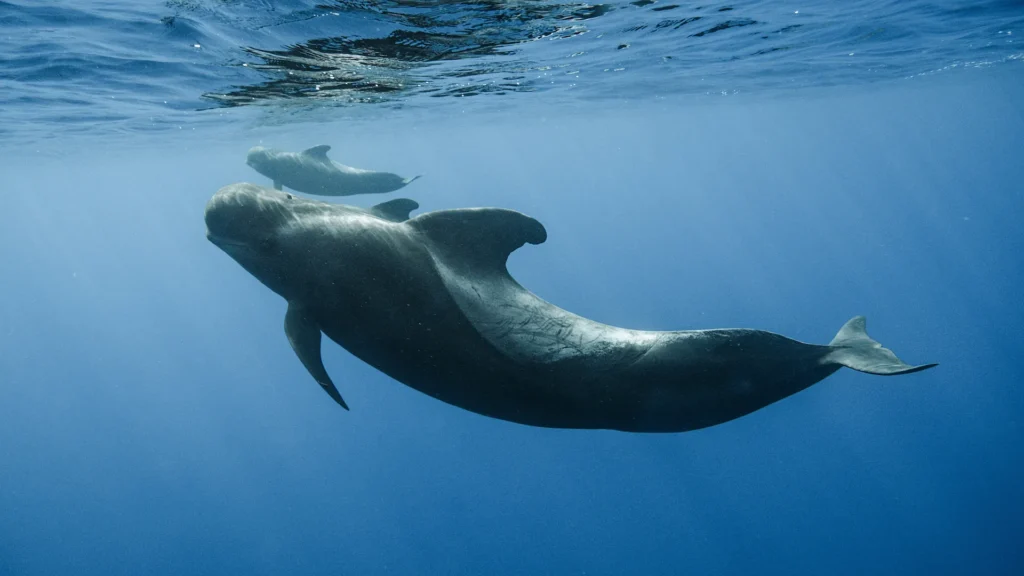

Short-Finned Pilot Whale
Short-Finned Pilot Whales are highly social marine mammals known for traveling in pods, sometimes numbering up to several dozen individuals. Growing up to 20 feet long, they are smaller than many other whales but are captivating due to their strong family bonds and fascinating behaviors. These whales are easily identified by their rounded, bulbous foreheads and dark, robust bodies. In Sri Lanka, they are often encountered alongside Sperm Whales, creating spectacular opportunities for observers to witness interactions between different whale species. Short-Finned Pilot Whales are deep divers, hunting squid and other prey far below the ocean’s surface. Their synchronized swimming, playful leaps, and close-knit pod dynamics make them a delight to watch. Because of their social nature, sightings often involve multiple whales surfacing and diving together, leaving onlookers in awe. Known as the “cheetahs of the deep,” their diving skills and hunting efficiency highlight their adaptability in diverse marine environments. Observing Pilot Whales in Sri Lanka is both a scientific and emotional experience, offering insights into their intelligence, cooperation, and resilience. Their presence enriches Sri Lanka’s whale watching industry, providing visitors with unforgettable encounters of marine life at its most dynamic and social.
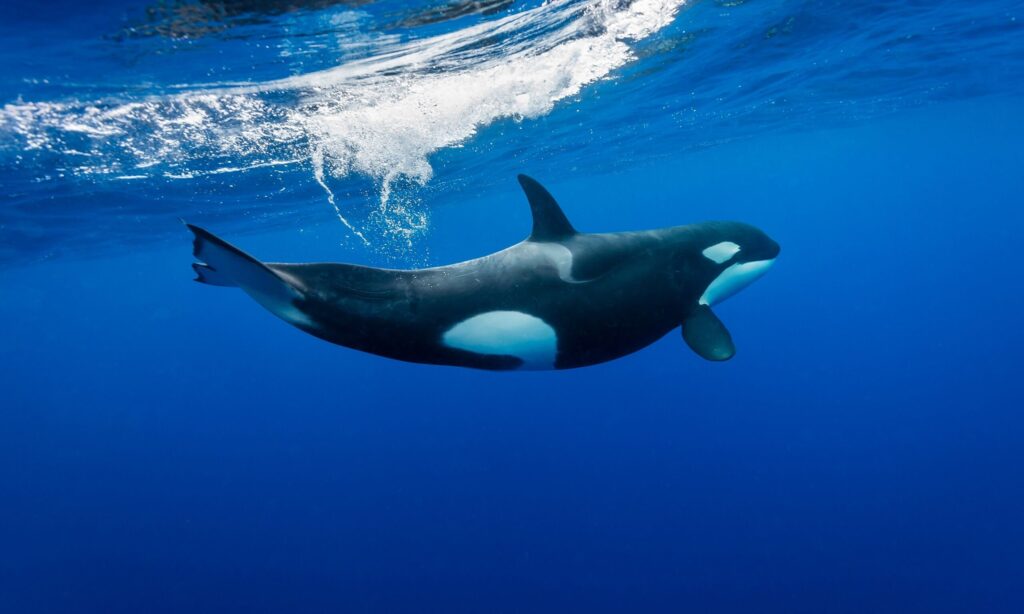
Killer Whale (Orca)
Killer Whales, or Orcas, are among the most iconic and powerful marine predators, though they are rare visitors in Sri Lankan waters. Instantly recognizable by their striking black-and-white coloration and tall dorsal fins, Orcas are highly intelligent and social creatures. They live in tightly bonded pods, communicating with unique vocalizations and working together to hunt. Their diet is diverse, ranging from fish to seals, dolphins, and even large whales, earning them the title of apex predators. While sightings in Sri Lanka are not frequent, they are extraordinary and unforgettable when they occur. For lucky whale watchers, observing an Orca slicing through the waters of the Indian Ocean is a thrilling and rare privilege. These rare encounters highlight the incredible biodiversity of Sri Lanka’s marine habitats. Orcas embody strength, intelligence, and adaptability, and their presence is a reminder of the interconnectedness of ocean ecosystems. The chance to spot them enhances Sri Lanka’s whale watching reputation, making the experience truly world-class. Even though rare, their occasional appearance adds an element of excitement and unpredictability, ensuring that every journey into the Sri Lankan seas holds the promise of something extraordinary.

Killer Whale (Orca)
Killer Whales, or Orcas, are among the most iconic and powerful marine predators, though they are rare visitors in Sri Lankan waters. Instantly recognizable by their striking black-and-white coloration and tall dorsal fins, Orcas are highly intelligent and social creatures. They live in tightly bonded pods, communicating with unique vocalizations and working together to hunt. Their diet is diverse, ranging from fish to seals, dolphins, and even large whales, earning them the title of apex predators. While sightings in Sri Lanka are not frequent, they are extraordinary and unforgettable when they occur. For lucky whale watchers, observing an Orca slicing through the waters of the Indian Ocean is a thrilling and rare privilege. These rare encounters highlight the incredible biodiversity of Sri Lanka’s marine habitats. Orcas embody strength, intelligence, and adaptability, and their presence is a reminder of the interconnectedness of ocean ecosystems. The chance to spot them enhances Sri Lanka’s whale watching reputation, making the experience truly world-class. Even though rare, their occasional appearance adds an element of excitement and unpredictability, ensuring that every journey into the Sri Lankan seas holds the promise of something extraordinary.
